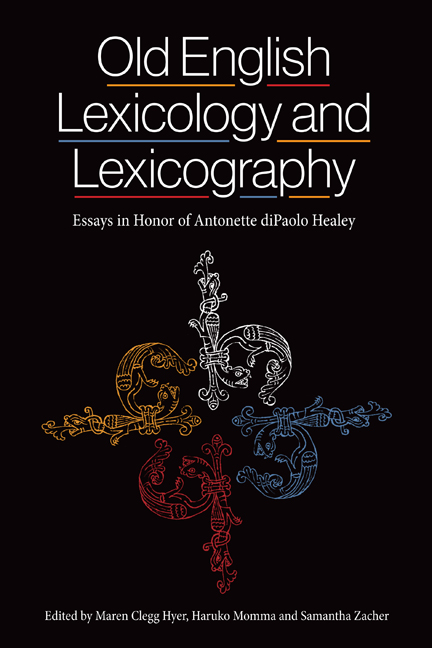Book contents
- Frontmatter
- Dedication
- Contents
- List of Illustrations
- List of Contributors
- Acknowledgements
- Abbreviations
- Introduction
- I Old English Poets and their Word-Craft
- 1 Beowulf and the Art of Invention
- 2 Juliana 53a Revisited (hætsð hæþenweoh)
- 3 Wounds and Compensation in the Old English Soul and Body Poems
- II Old English Homiletic Tradition
- 4 Defining and Redefining: Ælfric's Access to Gregory's Homiliae in Evangelia in the Composition of the Catholic Homilies
- 5 Lambeth Homily 4 and the Textual Tradition of the Visio Pauli
- 6 ‘A Vision of Souls’: Charity, Judgment, and the Utility of the Old English Vision of St. Paul
- 7 The Vocabulary of Sin and the Eight Cardinal Sins
- III Anglo-Saxon Institutions
- 8 The King (and Queen) and ‘I’: Self-Construction in Some Anglo-Saxon Royal Documents
- 9 Anglo-Saxon Maccabees: Political Theology in Ælfric's Lives of Saints
- 10 Nunne in Early Old English: Misogyny in its Literary Context
- IV Lexis of the Quotidian
- 11 Cingulum est custodiam: Semiotics and the Semantic Range of gyrdels
- 12 Island Time: The English Day and the Christian Hours
- 13 ‘Revising Hell’: The Voices of Teachers in Anglo-Saxon Studies and Anglo-Saxon England
- V The Task of the Lexicographer
- 14 Cryptography and the Lexicographer: Codifying the Code
- 15 Genre and the Dictionary of Old English
- Epilogue: Word-Hord
- 16 Reading Beowulf with Isidore's Etymologies
- An Old English Lexicon Dedicated to Toni Healey
- Toni Healey: A Tribute
- List of publications of Antonette diPaolo Healey
- Index
- Tabula Gratulatoria
- Miscellaneous Endmatter
- Anglo-Saxon Studies
12 - Island Time: The English Day and the Christian Hours
Published online by Cambridge University Press: 17 September 2020
- Frontmatter
- Dedication
- Contents
- List of Illustrations
- List of Contributors
- Acknowledgements
- Abbreviations
- Introduction
- I Old English Poets and their Word-Craft
- 1 Beowulf and the Art of Invention
- 2 Juliana 53a Revisited (hætsð hæþenweoh)
- 3 Wounds and Compensation in the Old English Soul and Body Poems
- II Old English Homiletic Tradition
- 4 Defining and Redefining: Ælfric's Access to Gregory's Homiliae in Evangelia in the Composition of the Catholic Homilies
- 5 Lambeth Homily 4 and the Textual Tradition of the Visio Pauli
- 6 ‘A Vision of Souls’: Charity, Judgment, and the Utility of the Old English Vision of St. Paul
- 7 The Vocabulary of Sin and the Eight Cardinal Sins
- III Anglo-Saxon Institutions
- 8 The King (and Queen) and ‘I’: Self-Construction in Some Anglo-Saxon Royal Documents
- 9 Anglo-Saxon Maccabees: Political Theology in Ælfric's Lives of Saints
- 10 Nunne in Early Old English: Misogyny in its Literary Context
- IV Lexis of the Quotidian
- 11 Cingulum est custodiam: Semiotics and the Semantic Range of gyrdels
- 12 Island Time: The English Day and the Christian Hours
- 13 ‘Revising Hell’: The Voices of Teachers in Anglo-Saxon Studies and Anglo-Saxon England
- V The Task of the Lexicographer
- 14 Cryptography and the Lexicographer: Codifying the Code
- 15 Genre and the Dictionary of Old English
- Epilogue: Word-Hord
- 16 Reading Beowulf with Isidore's Etymologies
- An Old English Lexicon Dedicated to Toni Healey
- Toni Healey: A Tribute
- List of publications of Antonette diPaolo Healey
- Index
- Tabula Gratulatoria
- Miscellaneous Endmatter
- Anglo-Saxon Studies
Summary
Colonizers bring with them their ‘empires of time’, in Anthony Aveni's evocative phrase; along with new laws, new configurations of power, and new economic relationships, colonization often involves the imposition of a new temporal discipline. The British, for example, began building clock towers in India shortly after the Sepoy Mutiny of 1857. These were meant to remind the natives of the power of the British Empire and to instill in them the Victorian virtue of punctuality; they were symbols of British authority and admonishments to the natives whose non-British sense of time led them to be characterized as lazy or morally deficient. The clock towers, some of which drew violent protest and vandalism, have been described as a kind of ‘reverse Panopticon’, asserting authority by pulling the gaze of others inward. The same description might apply to any tool imposed upon a population to discipline and constrain the inner life of its members, from new dress codes to new calendars.
In a broadly similar, though presumably less violent way, the conversion of the Anglo-Saxons to Christianity introduced the need for and the possibility of a new precision in time measurement and temporal observance, just as it introduced new social hierarchies, new centers of power and authority, and new standards of learning. The agrarian society of the early Anglo-Saxons was built around families, tribes, and land; their experience of time would have been determined by the rhythms of this way of life: planting and harvesting, calving and milking and slaughtering, winter and summer, the tides at sea, sunrise and sunset. The structure of daily life for farmers, herders, seafarers, and craftspeople would have followed the contours of these rhythms of nature; their larger sense of time would have arisen from long observation of the motion of the sun, moon, and stars across the sky.
To be sure, the church was also part of this agrarian world and equally subject to the rhythms of nature. But Christian observance required a qualitatively different experience of time, one dependent on social context rather than the natural environment. Christian time is a complex network of interlocking daily, weekly, and annual cycles, the sanctorale with its commemorations, the temporale with its great observances of Lent, Easter, and Pentecost, all superimposed on the natural rhythms of the day, month, and year.
- Type
- Chapter
- Information
- Old English Lexicology and LexicographyEssays in Honor of Antonette diPaolo Healey, pp. 186 - 198Publisher: Boydell & BrewerPrint publication year: 2020



